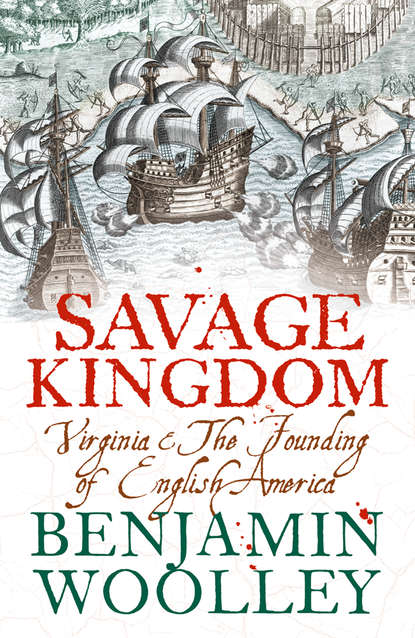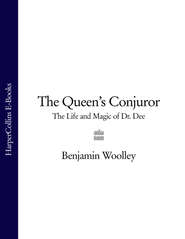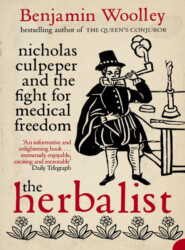По всем вопросам обращайтесь на: info@litportal.ru
(©) 2003-2024.
✖
Savage Kingdom: Virginia and The Founding of English America
Настройки чтения
Размер шрифта
Высота строк
Поля
(#litres_trial_promo)
However, Gosnold’s name had been conspicuous by its absence from the Virginia patent, and this seems to have been because it had become politically unacceptable. In 1604, a ‘Captain Gosnell’, probably Bartholomew, had made some intemperate remarks about King James at a dinner party held on the Isle of Wight. One of Cecil’s intelligencers happened to be among the guests, and he reported the remarks to his master, prompting a full-scale investigation by the Privy Council. No record remains of the council’s conclusions, but following such an episode, it was wise for someone bearing the Gosnold name to keep a low profile.
(#litres_trial_promo) For this reason, Gosnold might have drafted in Wingfield as his proxy, the two families having connections going back generations.
(#litres_trial_promo)
By the time of Smythe’s November gathering, Gosnold was able to adopt a more public role in the venture, and had secured a place for Archer in the forthcoming expedition. But as he and Wingfield were now to discover, neither was to be trusted with the role of mission commander. That role was to go to the formidable 46-year-old, one-armed veteran of the Spanish wars who now joined them: Christopher Newport.
Newport had been hired over the heads of the Virginia Company by the Royal Council. He had no previous connection to the Virginia venture, but was certainly qualified for the job. A war hero who had lost his right arm fighting in the West Indies, his reputation reached as far as Spain, where he was known as ‘un caballero muy principal’, a very great knight.
(#litres_trial_promo) In 1592, he had helped in the capture of the Portuguese carrack the Madre de Dios, the most magnificent prize of the Spanish war, estimated to be worth £150,000.
(#litres_trial_promo) Since the signing of the Somerset House Peace Treaty, he had continued to tour the Spanish Main, but for peaceful purposes, undertaking trade missions on behalf of a number of London merchants. He had returned from one trip with two baby crocodiles, which he presented to the King.
Unlike the other leading members of the venture, Newport was not expected to make any sort of investment in the company, nor to stay in Virginia. He would be responsible for commanding the expeditionary fleet, and leading the initial reconnaissance of the territory. In return, he was to be given sole ownership of any discoveries he made, including deposits of minerals and precious metals.
(#litres_trial_promo)
Such terms caused widespread resentment, because the other men of rank who had volunteered to go, many at this late stage in the preparations, were far more exposed. They were expected to pay not only their own way, but to recruit from their own estates the servants and labourers who would make up the bulk of the settlement’s workforce. They were also expected to pay the costs of sending these workers to America, and maintaining them while they were there.
In return for this investment, they were not even to take personal possession of the land upon which they settled. Instead, they were to receive a share in the Virginia Company’s overall profits. Their fortunes therefore rested principally on the speedy discovery of some valuable commodity, such as gold, copper, spices or medical ingredients, rather than the long-term development of the colony.
As most of these gentlemen well knew, the odds were unfavourable. The pages of Richard Hakluyt’s Principall Navigations were filled with horror stories of foreign ventures ending in slaughter or ruin. Just this month, Hakluyt had received reports of yet another disaster. A base set up in Guyana by the English captain Charles Leigh had been deserted following a series of mutinies, and a supply ship sent to relieve him had been forced to abandon sixty-seven passengers on the island of St Lucia, where they had all died of starvation or at the hands of the natives.
(#litres_trial_promo) Such were the risks faced by these planters. But then, in most cases, they were going not because of how much they had to gain, but how little they had to lose.
Despite his elevated status, George Percy was typical. Born on 4 September 1580, he was the sickly, epileptic runt of a litter of eight children fathered by Henry Percy, the eighth Earl of Northumberland. George’s family was renowned for its rebellions, which were being replayed every night on the London stage in Shakespeare’s history plays. Henry IV featured that ‘mad fellow of the north’ Henry Percy (the first Earl of Northumberland), and his son Harry Hotspur. ‘Zounds! I am afraid of this gunpowder Percy,’ says one character – a line written before the Gunpowder Plot, so acquiring uncomfortably prophetic force since the revelation that one of George’s kinsmen, Thomas Percy, was a ringleader.
(#litres_trial_promo) George was no Hotspur. In fact, he was a disappointment to his family and peers. Someone whispered into King James’s ear just before he succeeded to the English throne that George was hated ‘damnably’ by his brother the Earl, and one official in the Earl’s household was moved to describe George’s infirmities as ‘grievous and tedious’.
(#litres_trial_promo)
George had received the conventional education for a man of his class: Eton College, Oxford University, and the Middle Temple, for legal training. When he was sixteen, his mother had died, leaving him an annuity of around £60 a year, paid by the Earl’s staff. This was enough for a comfortable though not lavish standard of living for those who could keep within their means. However, George insisted on extravagance. He had a compulsion for keeping an impressively aristocratic wardrobe and table, having no title or property of his own to demonstrate his elevated rank.
Then came the discovery of the Gunpowder Plot. George was not implicated, but his elder brother and patron Henry, the current Earl of Northumberland, was found guilty of conspiracy, and committed to the Tower. Fined £30,000, Henry no longer felt in a position to support his aimless younger brother, so decided to send him to Virginia. As well as keeping him a safe distance from the political fray, the expedition also promised some alleviation of George’s epilepsy, for, as he would later write, ‘my fits here in England are more often, more long and more grievous, than I have felt them in other parts nearer the line [equator]’.
He had to pay a high price for a place in the venture. He was apparently forced to hand over his annuity to his brother, and to borrow £8 16s from another adventurer to help cover his costs – a debt which he had still to repay years later. Meanwhile, his expenses were far from modest. He subsequently sent home requests to his brother for ‘diverse suits’ (£32 14s 7d), knives (3s), books, paper, ink and wax (£1 14s 9d), biscuits (£3 5s), cheese (8s 2d), butter (£1 17s), soap, lights and starch (13s 6d), storage chests (12s), assorted boxes (10d) and casks (6s 2d). He even asked for a feather bed, complete with bolster, blankets and a covering of tapestry.
(#litres_trial_promo)
Percy was a name of French origin going back to the Norman invasion of England, breathed in the rarefied atmosphere of royal courts. In contrast, the name that was to become most closely associated with the Virginia story, and intimately linked to the legend of the Indian princess Pocahontas, carried a whiff of the Anglo-Saxon village forge: John Smith.
A wide, barely navigable ocean divided Smith’s world from Percy’s. Percy was the product of generations of aristocratic breeding and refinement; the stout, bearded Smith prided himself on being a self-made man. ‘Who can desire more content that hath small means, or but only his merit to advance his fortunes, than to tread and plant that ground he hath purchased by the hazard of his life,’ Smith wrote.
(#litres_trial_promo) Nevertheless, Smith had one thing in common with Percy: a feeling of social exclusion, of otherness, that made the prospect of starting afresh in the New World irresistible.
According to Smith’s vivid, if sometimes incoherent and unreliable autobiography, True Travels, he was ‘born in Willoughby in Lincolnshire’. His father was ‘anciently descended from the ancient Smiths of Crudley in Lancashire; his mother from the Rickards at Great Heck in Yorkshire’. He was christened with that most ordinary of names at Willoughby by Alford on 9 January 1580. The ceremony took place in the local parish church, which, like many others in a region of reclaimed marshland that could be treacherous to travel, was dedicated to St Helen, patron saint of travellers.
He described these as ‘poor beginnings’, so poor as to earn the scorn of his high-born adversaries. But he was not quite as humble as he sometimes claimed. His father, George, was among the better-off farmers in the region, owning the freehold of several acres of pasture in Great Carlton and property in the market town of Louth. He also leased fields off the local lord, Peregrine Bertie, Baron Willoughby of Eresby. Young John was brought up in a substantial farmhouse comprising a hall, three chambers, a ‘milkhouse’ and a ‘beasthouse’, and with several servants.
(#litres_trial_promo)
The next stage in John’s life, according to his autobiography, was ‘his parents dying when he was about thirteen years of age’. They left him with ‘a competent means, which he not being capable to manage, little regarded’.
(#litres_trial_promo) This is a curious passage, as both parents were very much alive when he was ‘about thirteen’: his father died when Smith was sixteen, and his mother many years later, having remarried.
His mind being ‘even then set upon brave adventures’, he was apprenticed to a merchant in King’s Lynn, Norfolk. Bondage to a master did not suit his restless spirit, and soon afterwards he tore up his seven-year indenture and headed off to find new adventures. This probably happened around the time his father died, and produced a rift with his mother, which would explain his decision to write both of them prematurely out of his life.
The elective orphan, free of family ties and the responsibilities of having to manage his father’s farm, went to the Low Countries. Unfortunately for Smith, his arrival coincided with a lull in hostilities, a side effect of Cecil’s peace treaty with Spain. This forced an early return to England. Smith then embarked on a tour of France in the company of Peregrine Bertie, the son of his father’s patron. Returning again to the Low Countries, and finding the opportunities for military glory still limited, he ended up in Eastern Europe, where war between the Holy Roman and Ottoman empires raged more reliably. Though the Holy Roman Emperor Rudolf II was Catholic, this was of no consequence to an English Protestant with military ambitions.
He enlisted with the battalion of a Slovenian warlord, and marched to Transylvania, on the front line of the war. There, during a siege, he claimed to have beheaded three ‘Turks’ single-handedly before the massed ranks of the opposing Christian and Muslim armies. For this act of bravery, the King of Poland granted him a coat of arms, the title of Captain and the status of ‘an English gentleman’.
He was soon after wounded during a skirmish with Tartars and taken prisoner. He and his fellow captives were sent to Axiopolis (modern Cernavoda), a market town on the banks of the Danube, and ‘sold for slaves, like beasts in a market-place; where every merchant, viewing their limbs and wounds, caused other slaves to struggle with them, to try their strength’.
A dealer bought the young soldier for a client in Constantinople, who turned out to be the beautiful daughter of a Greek noblewoman whom Smith called Charatza Trabigzanda (probably mistaking the Greek description of her as a girl from Trebizond).
(#litres_trial_promo) She soon ‘took (as it seemed) much compassion on him’, but not yet being of age, and fearful that he would be sold on, sent him to her brother, a military official working near the Black Sea, ‘till time made her Master of her self’. But ‘within an hour after his arrival’, the brother commanded his servant to strip Smith naked, ‘and shave his head and beard so bare as his hand’ and place ‘a great ring of iron, with a long stalk bowed like a sickle, riveted about his neck’. After enduring several months of this treatment, Smith ‘beat out [his master’s] brains with his threshing bat’, stole his victim’s clothes, and made his escape along an ancient caravan route to Astrakhan. He vividly recalled a journey along this intersection of Asiatic trade, each crossroads being marked with a signpost showing the way to the Crimea with a crescent moon, to Moscow with a cross, and to China with a sun. Ending up in Prague, the capital of the Holy Roman empire, he embarked on another epic trek through Germany, France and Spain to the Barbary coast of North Africa, where he hitched a lift with French pirates. Narrowly escaping Spanish capture and being blown up by an on-board explosion, he returned to England.
(#litres_trial_promo)
It is not clear how Smith was introduced to the Virginia venture. At the time Gosnold was promoting the idea in London, he appears to have been staying with or near Robert Bertie at the Willoughby London residence in the Barbican. Robert’s father had shown an interest in the Roanoke venture, and he had family connections to both the Wingfields and Gosnolds, so Robert may have effected an introduction.
(#litres_trial_promo)
Whatever Smith’s credentials, he, like Newport and Gosnold, had at least made a name for himself in the world of military and maritime affairs. The same could not be said of two mysterious figures mingling among the assembled adventurers and planters on that November day. Smythe introduced them as John Ratcliffe and George Kendall. They were to take a prominent though as yet unspecified role in the forthcoming expedition, the assembly was informed. Nothing further was revealed about these men, other than perhaps the merest hint that their participation was non-negotiable, as they had been appointed at the personal behest of Robert Cecil himself.
FOUR Departure (#ulink_0e7ba2b0-1812-54a5-b045-d7f13b0697db)
BY LATE NOVEMBER 1606, preparations for the Virginia Company’s first expedition were well advanced. Edward Maria Wingfield had packed a trunk with reading material, together with ‘diverse fruit, conserves and preserves’, and dispatched it to Richard Crofts, probably a relative of the Herefordshire landowner and MP Sir Herbert Crofts.
Crofts lived at Ratcliffe, a hamlet on the north bank of the Thames. The stretch of river overlooked by his house was used to moor ships, and on 23 November the Susan Constant, the 170-ton flagship for the Virginia fleet, arrived, heavily laden with supplies for her forthcoming voyage. She was tied up alongside the Philip and Frances, and Crofts dutifully ensured that Wingfield’s precious trunk was safely stowed in one of the cabins. A consignment of clucking hens and a cockerel was also delivered, from which Wingfield hoped to breed a flock to provide himself, and possibly his associates, with fresh eggs and an occasional chicken for the pot once in America.
That night, the Susan Constant began to shift with the ebb tide. Being so heavily laden, she was difficult to control, and crashed against the neighbouring ship, damaging the Philip and Frances’s bowsprit, sheet anchor and beak-head (defined by Captain John Smith as the part of the ship ‘before the forecastle, and of great use, as well for the grace and countenance of the ship, as a place for men to ease themselves in’).
(#litres_trial_promo) When the master of the Philip and Frances boarded the Susan Constant to remonstrate with the crew, he claimed to find them ‘tippling and drinking’.
(#litres_trial_promo)
The Susan Constant suffered minor damage to two of her portholes, but she was soon patched up, and a few days later moved further downstream to Blackwall, where she was to rendezvous with her two companion vessels: the 40-ton Godspeed and the 20-ton Discovery. Of the three ships, only the Discovery, a small bark or ‘pinnace’, was actually owned by the Virginia Company. She was to remain in Virginia for use by the settlers, while the other two hired vessels would return to England, laden, it was hoped, with valuable commodities.
On 10 December, ten days before the ships were due to sail, the mission’s leaders were once again summoned to Philpot Lane, this time to receive their final ‘Orders and Directions’ from the Royal Council.
Newport was confirmed as admiral, having ‘sole charge’ of the venture while he was in Virginia. He was also given the box containing the list of names for the local council, which he was under orders to ensure remained sealed until the fleet arrived in America. Meanwhile, he was left to appoint the ‘captains, soldiers and mariners’ for the voyage. Reflecting his experience and prominent role in getting the venture off the ground, Gosnold was put in charge of the Godspeed while, to everyone’s surprise, the mysterious Ratcliffe was given command of the Discovery.
The expedition leaders were then handed a set of ‘Instructions given by way of Advice’, drawn up by Richard Hakluyt. These distilled the collective wisdom of the adventurers’ forerunners, and showed that a great deal had been learned from their abundant mistakes.
Hakluyt insisted that, on arrival in America, their first job was to anchor the fleet in a ‘safe port’ at the mouth of a navigable river. The river was to be the one that ‘runneth furthest into the Land’ and ‘bendeth most towards the Northwest’, in the hope that it might be that mentioned by the Indians at Roanoke, leading to the Appalachian Mountains and even the Pacific.







